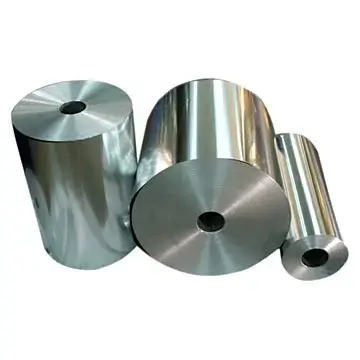Foil is a type of flat rolled metal. Typically the material has a thickness of 5 to 150 micrometers. Samples with parameters above 0.15 mm are available in the form of plates, sheets and strips.Main varieties.
There are several types of foil. They differ in operational characteristics and areas of application: 1. Hot stamping material. It is produced by pressing paper or other material onto the raw material using a heated stamp. The method has a number of drawbacks: it does not allow the formation of a full-color image with color transitions and shades.2. Cold stamping. Intended for subsequent pressing of thin film. This variety is in demand when decorating packages and label tapes. The facing layer can be screened with different color shades.3. For foiling. This material is applied on top of the image printed using a laser printer.4. Metallized. Samples are rarely offered in "natural color". This variety is often used with paint coating.5. Colored (pigmented). This type acquires a matte and glossy effect during processing. There are several popular colors on sale: orange, black, white, blue, yellow. Matte foil can be used to seal a surface with a gloss or varnish finish.6. Texture. It is a metal sheet with a pattern that imitates the texture of leather, wood or stone.7. Holographic. The main scope of application is the creation of a protective barrier on the surface.8. Diffraction. It has a lower degree of protection compared to the previous type, but is used for packaging flexible products made of plastic and paper. Using this foil, printing with different varnish coatings is carried out.9. Magnetic. It is processed with a special magnetic layer and is used to issue transport cards or bank documentation.10. Sketch foil. Used as a coating layer for plastic cards and lottery tickets. Under the main layer there is a special code combination. The method allows you to protect it from unauthorized receipt.
Manufacturing technology and scope of application.
The following technological steps are used for the production of foil: 1. Hot rolling.2. Cold rolling of strip.3. Cold rolling of foil.4. Cutting and forming rolls for further use.
Finished raw materials are widely used in the food industry as metal packaging solution. Its areas of operation also include the pharmaceutical industry. In construction activities, the material is intended for vapor and thermal insulation of structures. Printing types of foil allow for the embossing procedure.
The thinnest type is gold foil. It has a thickness of 0.00001 mm. Metal ingots are heated to 5500 °C and undergo the primary processing stage. As a result, they acquire a thickness of 0.6-1 cm and are sent to the crimping machine. Then the strips are cooled and rolled again to obtain parameters of 0.2-0.6 mm.
Raw materials for production.
Pure aluminum. Instead, special alloys with manganese, copper, iron and other types of metals are used. Primary aluminum samples are no longer used for the production process. Instead, recycled materials are used, for example, cans of alcoholic beverages and energy drinks, plastic packaging and foil-coated paper.
The use of recycled materials provides energy savings of up to 90%, compared to the use of primary alloys. Every year, advanced technologies and new types of waste are introduced into production. They reduce the cost of producing foil and make it environmentally friendly.
Properties of aluminum foil.
Foil, which is produced on the basis of aluminum, has the following characteristics:1. Tightness - the material creates protection on the surface from moisture, oily substances, fats, products of the oil refining industry and chemical reagents. In addition, it forms a barrier against vapors and gases, microorganisms, and ultraviolet radiation.2. Resistant to corrosion and neutral to chemicals - this feature allows the use of raw materials for packaging purposes.3. Heat resistance and thermal conductivity - due to these properties, foil is suitable for subsequent heat treatment and sterilization of packaged products.4. Electrical conductivity.
A detailed description of the properties can be found in Metal Foil Handbook. To turn a metal ingot into a final product, a rolling mill must be used. With the help of




